With risky prospects on far-northern islands and at a premium aboard aircraft, observers looked on with awe as the Moon's shadow swept across the Arctic Ocean.
Today's total solar eclipse has come and gone, and now some of the stories of diehard amateur astronomers who went to great lengths and costs to observe it can be told.
Earth-Moon geometry combined to create a path of totality that began over the North Atlantic well south of Greenland, just missed clipping Iceland, and then arced up into the remote Arctic Ocean before lifting off Earth at the North Pole. The only bits of dry land in this eclipse's unusually wide swath (due to the lunar shadow's relatively glancing contact) were the remote Faroe Islands and the Svalbard archipelago.

Alson Wong
Observers who trekked to the Faroes had mixed success. Some observers saw none of the eclipsed Sun at all. From a spot southwest of Tórshavn, the capital and largest city, David Baron caught only a glimpse of the partial phases leading up to the big event. "I saw the corona for about two seconds before third contact," he reports. "A half hour later, the skies became gloriously clear." At the Vagar airport, onlookers caught about 1¼ minutes of totality. "The diamond ring through cloud (with iridescence) was amazing," says Paul Deans, "and the prominences and corona were stunning." But clouds rolled in before third contact, and about 5 minutes later, it was raining.
It was a different story in Svalbard, farther northeast along the track. There crystal clear skies — and bitter cold — ruled the day. Here's a report from Canadian meteorologist Jay Anderson:
"We had an exceptional eclipse on Svalbard, with crystal-clear skies, light winds, and bitter temperatures. The Sun was perfectly positioned in a notch in the hills to the south, while prominent snow-mantled mountains set off the north. The corona was a stunning solar-max prototype. I counted eight helmet plumes as seen through binoculars but could have added more. Two prominences stood out on the top and left and several minor ones completed the lunar necklace. We saw shadow bands on ingress and egress, for about 15 seconds at each contact.
"Temperatures fell from –16° to –22°C, according to one measurement. Those using computers for control were usually frustrated, as the temperatures took their toll on screens and processors. Frozen fingers were a problem as well, but more easily overcome. No polar bears and the dogs on the hill above were silent. The final diamond ring was stunning in the brilliant Arctic transparency. Svalbard definitely had the classiest view in this eclipse, on ground or in the air."
The View from On High
But Anderson will get an argument about those bragging rights from those who took to the skies to see totality. More than a dozen planes headed toward the eclipse's centerline, and some ended up "stacked" 1,000 feet apart in altitude by Iceland's air-traffic controllers, who had their hands full this day (in part because many transatlantic flight were in the area as well."
The aircraft didn't have clouds to contend with, though partial window icing was a nuisance for some travelers who had paid premium prices for window seats. Still, virtually everyone got a great view — and, thanks to the planes' velocity, experienced a duration of totality up to a minute longer than was possible from the island sites.
Another plus was simply being high up. (One of the smaller private chartered jets streaked along the centerline at 49,000 feet!) The Moon's shadow overtook the planes from behind, providing especially dramatic views as the umbra swept over and engulfed the white cloud decks below. The totally eclipsed Sun displayed a patchwork of electric-white corona and brilliant red chromosphere around its limb.

Robert Stephens
With sky clarity not an issue from the high-altitude vantage point, some veteran "umbraphiles" covered one eye with a black eyepatch or wore deep-red goggles to keep an eye or two dark-adapted for totality. A goggled Landon Noll told me that during totality he saw coronal streamers extending out to three times the Sun's diameter.
And what about that Icelandair flight from Reykjavik to London that was going to cross the lunar shadow by pure coincidence? Alas, it was not to be. "It started perfectly," explains passenger Olivier "Klipsi" Staiger. "We boarded the plane. We waited. They even distributed eclipse shades to the passengers. And we waited — and had a technical problem with the aircraft." Everyone had to leave the plane, and they had to settle with seeing a deep partial eclipse from Iceland's Keflavik airport.
Did you get to see this eclipse, either as a "total" spectacle or a partial eclipse? If so, take a moment to offer your impressions in the Comment section below.
The next total solar eclipse occurs on March 9, 2016. Consider joining Sky & Telescope's eclipse cruise in Indonesia.
 2
2
Comments
Alex-Burda
March 21, 2015 at 11:20 am
From Bucarest (Romania) the eclipse was a partial one at 43% coverage of the Sun. And although the weather was against observing such a fascinating astronomical event, the first half of it was visible and spectacular.
https://s-media-cache-ak0.pinimg.com/originals/59/f1/e3/59f1e31bd20f0b9253574f586fa952cf.jpg
You must be logged in to post a comment.
andy
March 30, 2015 at 3:44 am
I was lucky enough to have clear skies for the morning of the eclipse here in Northamptonshire, UK.
I have created a short video clip with the 800 photos taken of the eclipse.
https://youtu.be/67JRsU1UYRY
You must be logged in to post a comment.
You must be logged in to post a comment.